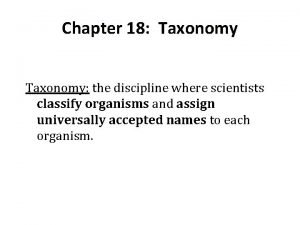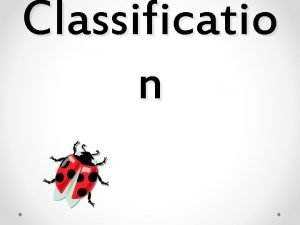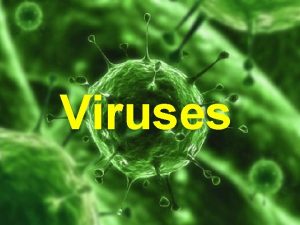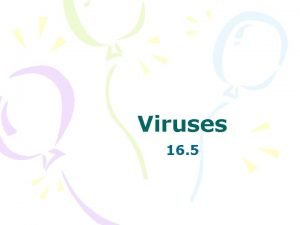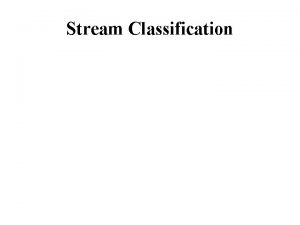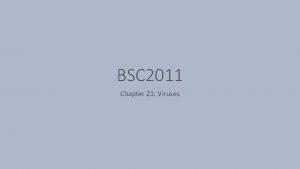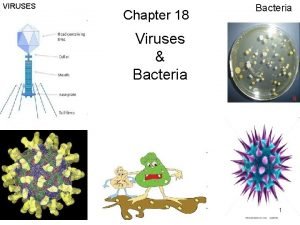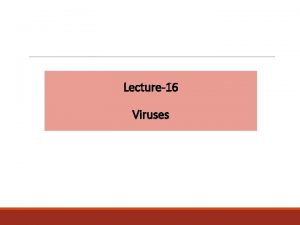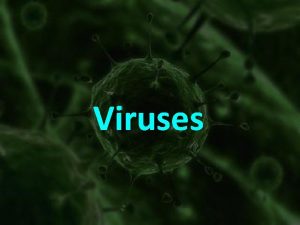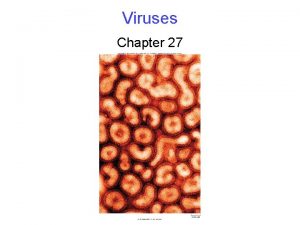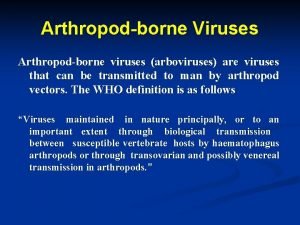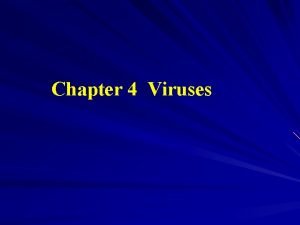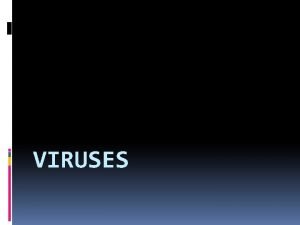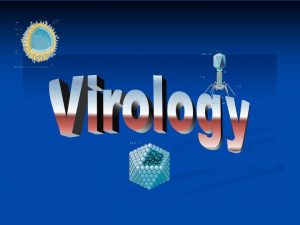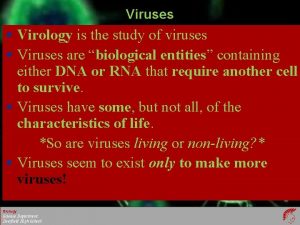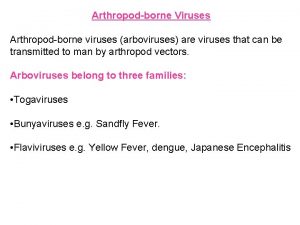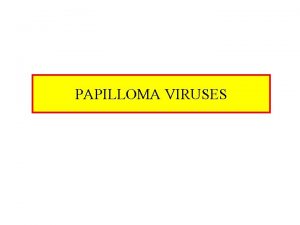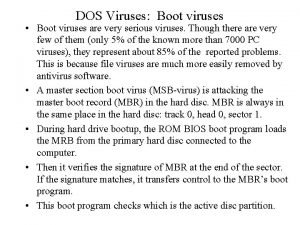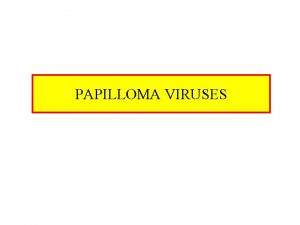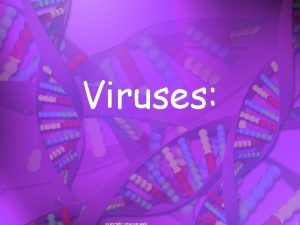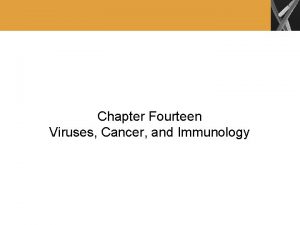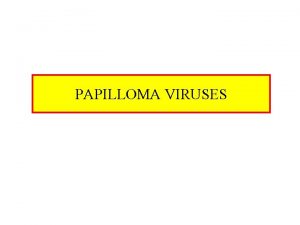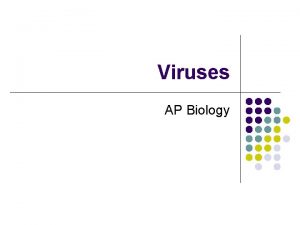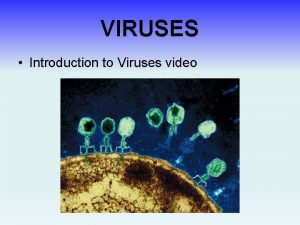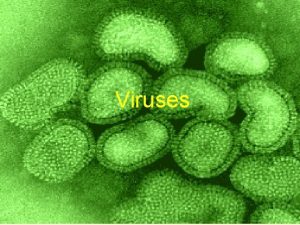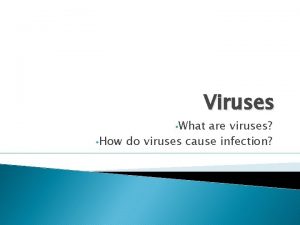Warmup 1 Why do many scientists classify viruses





























- Slides: 29

Warm-up 1. Why do many scientists classify viruses as non-living? 2. Draw the basic structure of a virus. Label and define capsid, viral envelope and nucleic acid.

Warm-up 1. Draw the lytic/lysogenic cycle. 2. What stage of the lytic-lysogenic cycle is a virus virulent? Temperate? 3. What determines a host range?

Viruses

What you must know: The components of a virus. The differences between lytic and lysogenic cycles. How viruses can introduce genetic variation into host organisms. Mechanisms that introduce genetic variation into viral populations.

Bacteria vs. Viruses Bacteria Prokaryotic cell Most are free-living (some parasitic) Relatively large size Antibiotics used to kill bacteria Virus Not a living cell (genes packaged in protein shell) Intracellular parasite 1/1000 size of bacteria Vaccines used to prevent viral infection Antiviral treatment

Viruses Very small (<ribosomes) Components = nucleic acid + capsid ◦ Nucleic acid: DNA or RNA (double or single-stranded) ◦ Capsid: protein shell ◦ Some viruses also have viral envelopes that surround capsid

Viruses Limited host range ◦ Entry = attach to host cell membrane receptors through capsid proteins or glycoproteins on viral envelope (animal) ◦ Eg. human cold virus (rhinovirus) upper respiratory tract (mouth & nose) Reproduce quickly within host cells Can mutate easily ◦ RNA viruses: no error-checking mechanisms




Simplified viral replicative cycle

Viral Reproduction Lytic Cycle: ◦ Use host machinery to replicate, assemble, and release copies of virus ◦ Virulent phages: Cells die through lysis or apoptosis Lysogenic (Latent) Cycle: ◦ DNA incorporated into host DNA and replicated along with it ◦ Bacteriophage DNA = prophage ◦ Animal virus DNA = provirus ◦ UV radiation, chemicals: lysogenic lytic cycle ◦ Temperate Phage: uses both methods of replication

Bacteriophage Virus that infects bacterial cells

Lytic Cycle of T 4 Phage

Lytic Cycle vs. Lysogenic Cycle

Animal viruses have a membranous envelope Host membrane forms around exiting virus Difficult for host immune system to detect virus

Retrovirus RNA virus that uses reverse transcriptase (RNA DNA) Newly made viral DNA inserted into chromosome of host (provirus) provirus Host transcribes provirus to make new virus parts Example: HIV (Human Immunodeficiency Virus)

HIV = Retrovirus

HIV ◦ Origin: Chimpanzee virus ◦ Infects white blood cells (helper T) ◦ HIV+: provirus (DNA inserted), latent ◦ AIDS: <200 WBC count, opportunistic infections

Other Human Viruses Herpes virus Smallpox Herpes Simplex Virus 1 (HSV-1) Herpes Simplex Virus 2 (HSV-2) Eradicated in 1979 due to worldwide vaccination campaigns

Emerging Viruses = mutation of existing viruses Pandemic: global epidemic

Current Outbreaks Zika Virus ◦ Spread by Aedes mosquitoes (Aedes aegypti) ◦ Major outbreak in Brazil and Latin America ◦ Linked to birth defects (microcephaly) Dengue Fever Chikungunya

Zika Virus (as of Dec. 2015)

Drugs for Prevention/Treatment Vaccine: weakened virus or part of pathogen that triggers immune system response to prevent infection ◦ Ex. HPV, MMR, Hep. A, Flu shot Antiviral Drugs: block viral replication after infection ◦ Ex. Tamiflu (influenza), AZT (HIV)


Viroids Small, circular RNA molecules that infect plants Cause errors in regulatory systems that control plant growth Eg. coconut palms in Philippines

Prions Misfolded, infectious proteins that cause misfolding of normal proteins Eg. scrapie (sheep), mad cow disease (BSE), Creutzfeldt-Jakob disease (humans), kuru (humans – New Guinea)

Diseases caused by prions Prions act slowly – incubation period of at least 10 years before symptoms develop Prions are virtually indestructible (cannot be denatured by heating) No known cure for prion diseases Kuru in New Guinea

Prion Neurodegenerative Diseases Alzheimer’s Disease Parkinson’s Disease
 Https://m..com/watch?v=nqecciuc7jy
Https://m..com/watch?v=nqecciuc7jy Youtube
Youtube The scientific discipline of classifying organisms
The scientific discipline of classifying organisms Why do biologists classify
Why do biologists classify How do scientists classify stars
How do scientists classify stars What are the properties used to classify stars
What are the properties used to classify stars Classification of plants
Classification of plants How do scientists classify organisms
How do scientists classify organisms What is classificatio
What is classificatio Hey bye bye
Hey bye bye Why are viruses considered nonliving?
Why are viruses considered nonliving? Why are viruses considered nonliving
Why are viruses considered nonliving Scientists divide the atmosphere into how many layers?
Scientists divide the atmosphere into how many layers? Warmup ratio
Warmup ratio Warmup 65
Warmup 65 Gmass warmup
Gmass warmup Status vs class
Status vs class Pyramid warmup
Pyramid warmup Mind rhyming words
Mind rhyming words Product of powers
Product of powers Java warmup
Java warmup Define:warmup
Define:warmup Ethos warmup
Ethos warmup Tinman warmup
Tinman warmup Warmup 65
Warmup 65 Warmup end
Warmup end Sigfig rules
Sigfig rules First layer of the earth
First layer of the earth 6-1 classifying quadrilaterals
6-1 classifying quadrilaterals Dont ask why why why
Dont ask why why why


